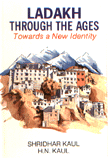 Ladakh through the ages
Ladakh through the ages

Ladakh, situated at breath-taking altitudes (11,500 ft and above) in the Himalayas offers both irresistible and awe-inspiring beauty which nature has bestowed on it. But, unfortunately, despite its being sensitive and strategic, it has remained neglected for a long time.
This book gives a lucid account of Ladakh’s geographical profile, historical background, religion, social structure nad customs and the whole gamut of its post-independence problems and developments.
Events of interest and importance with some untold developments which comprise an integral part of the history of this region have also been discussed in this book. With its composite theme covering diverse facets of Ladakh, it is hoped, the book will serve as a standard reference book on the region.
The Contents
Foreword
Preface
Acknowledgement
Part I
1. Geographical Profile
2. Historical Background
3. Under the Dogra Rule (1834-1947)
4. Religion
5. Social Structure and Customs
6. In the Wake of Partition
Part II
7. Twilight of Transition
8. Shadow of Autonomy
9. Storm in a Tea Cup
10. The Protest
11. History Repeats Itself
12. The Regional Imbalances
13. The Nightmare Persists
14. Cultural Heritage and Development
15. Future of Ladakh
Annexures
Glossary
Bibliography
Index
Plates
|
|
Shridhar Kaul, was a person of profound erudition, a renowned Kashmiri scholar, a dedicated social worker and a devout Buddhist by conviction. His contribution towards Ladakh in peace and war, his dedicated endeavours in putting Ladakh on the educational map of Kashmir and, above all, his missionary zeal in awakening Ladakhis, are two well known to need detailed mention.
H.N. Kaul took his degree from Punjab University, Lahore, followed by a postgraduate degree in Pol. Science and a degree in Law from Lucknow University in 1947. He has had a long innings in Govt. of India having served its various departments for four decades. During his tenure at Leh in Military Intelligence Directorate, the movement launched by Ladakhis was at its peak. After his retirement from U.G.C., his decade-old stint in Minorities Commission contributed to his closer interaction with Ladakhis. His association with some international Buddhist organizations took him round several times to the former Soviet Union and Mongolia and recently to China and Thailand. |